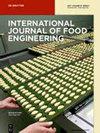Comparative study on enzyme activity, microstructure, drying kinetics, and physicochemical properties of apple slices affected by microwave and steam blanching
IF 1.6
4区 农林科学
引用次数: 0
Abstract
The influence of microwave blanching (MWB) at different times (30–120 s) on the physicochemical properties, microstructure, and drying characteristics of apple slices, compared to steam blanching (SB) was investigated. Results showed that MWB resulted in greater weight loss and more efficient enzyme inactivation efficiency than SB. The MWB process facilitated the moisture diffusion, resulting in a significant (p < 0.05) reduction in drying time of up to 27.78 % and specific energy consumption of up to 50.00 %. Microstructural observations confirmed that this result stemmed from the development of microporous channels within the cellular tissue structure. The Page model exhibited a higher applicability to the drying of apple slices. Moreover, MWB was more effective than SB in inhibiting browning and retaining phenolic compounds. However, concerning amino acid retention, the dried samples treated with SB for 30 s (21.36 ± 0.83 mg/g DW) showed superior performance compared to dried samples treated with MWB. In addition, molecular docking results suggested that amino acids could form the distinctive flavor of dried apple slices through hydrogen bonding with taste receptors.受微波和蒸汽焯烫影响的苹果片的酶活性、微观结构、干燥动力学和理化特性的比较研究
与蒸汽焯水(SB)相比,研究了不同时间(30-120 秒)的微波焯水(MWB)对苹果片的理化性质、微观结构和干燥特性的影响。结果表明,与 SB 相比,MWB 导致的重量损失更大,酶失活效率更高。MWB 工艺促进了水分扩散,使干燥时间显著缩短(p < 0.05)达 27.78%,比能量消耗显著降低(p < 0.05)达 50.00%。微观结构观察证实,这一结果源于细胞组织结构中微孔通道的形成。佩奇模型对苹果片的干燥具有更高的适用性。此外,在抑制褐变和保留酚类化合物方面,MWB 比 SB 更有效。然而,在氨基酸保留方面,经 SB 处理 30 秒的干燥样品(21.36 ± 0.83 mg/g DW)比经 MWB 处理的干燥样品表现更佳。此外,分子对接结果表明,氨基酸可通过与味觉受体的氢键结合形成苹果干片的独特风味。
本文章由计算机程序翻译,如有差异,请以英文原文为准。
求助全文
约1分钟内获得全文
求助全文
来源期刊
CiteScore
3.20
自引率
0.00%
发文量
52
审稿时长
3.8 months
期刊介绍:
International Journal of Food Engineering is devoted to engineering disciplines related to processing foods. The areas of interest include heat, mass transfer and fluid flow in food processing; food microstructure development and characterization; application of artificial intelligence in food engineering research and in industry; food biotechnology; and mathematical modeling and software development for food processing purposes. Authors and editors come from top engineering programs around the world: the U.S., Canada, the U.K., and Western Europe, but also South America, Asia, Africa, and the Middle East.

 求助内容:
求助内容: 应助结果提醒方式:
应助结果提醒方式:


